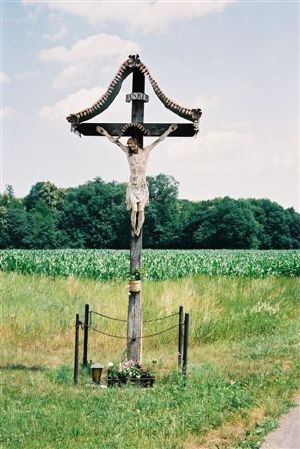Crucifix
A crucifix (from Latin cruci fixus meaning "(one) fixed to a cross") is a cross with a representation of Jesus' body, or corpus. It is a principal symbol of the Christian religion. It is primarily used in the Catholic, Anglican, and Eastern Orthodox Churches and emphasizes Christ's sacrifice— his death by crucifixion.
The Crucifix
On some crucifixes a skull and crossbones are shown below the corpus, referring to Golgotha (Calvary), the site at which Jesus was crucified—"the place of the skull." It was probably called "Golgotha" because it was a burial-place, or possibly because of a legend that the place of Jesus' crucifixion was also the burial place of Adam. The standard, four-pointed Latin crucifix consists of an upright stand and a crosspiece to which the sufferer's arms were nailed.
The Eastern Christian crucifix includes two additional crossbars: the shorter nameplate, to which INRI was affixed; and the shorter stipes, to which the feet were nailed, which is angled upward toward penitent thief St. Dismas (to the viewer's left) and downward toward impenitent thief Gestas (to the viewer's right). It is thus eight-pointed. The corpora of Eastern crucifixes tend to be two-dimensional icons that show Jesus as already dead, as opposed to the depictions of the still-suffering Jesus that can be found in some other Churches. Also, Eastern crucifixes have Jesus' two feet nailed side by side, rather than one atop the other, as Western crucifixes do. The crown of thorns is also generally absent in Eastern crucifixes.

Another depiction shows a triumphant risen Christ (clothed in robes, rather than stripped as for his execution) with arms raised, appearing to rise up from the cross, sometimes accompanied by "rays of light."
Usage
Anglican, Roman Catholic, Orthodox, and Coptic Christians generally use the crucifix in public religious services. They believe the crucifix is in keeping with Scripture, which states that “We preach Christ crucified, unto the Jews a stumbling block, and unto the Greeks foolishness.”[1]
Prayer in front of a crucifix is often part of devotion for Christians, especially those worshipping in a church, and private devotion in a chapel. The person may sit, stand, or kneel in front of the crucifix, sometimes looking at it in contemplation, or merely in front of it with head bowed or eyes closed. In the Roman Catholic Mass, and Anglican Holy Eucharist, a procession begins Mass in which a crucifix is carried forward into the church followed by lector and servers, the priest, deacon, along with some of the other items used in the service such as the Gospels and the altar candles. Eastern Christian liturgical processions also include a crucifix at the head of the procession.
The crucifix is also considered by some to be one of the most effective means of averting or opposing demons, as stated by many exorcists, including the famous exorcist of the Vatican, Father Gabriele Amorth. In folklore it is considered to ward off vampires, incubi, succubi, and other evils.
Gallery
- Krucifix.jpg
crucifix in front of the Holy Spirit Church in Košice, Slovakia
- Small crucifix.jpg
A handheld crucifix
- Baux-de-provence-eglise-st-vincent-crucifix.jpg
A crucifix in a church, with votive candles.
- CrcifxStP1010002.JPG
A crucifix outside an Anglican church<ref>In Petersfield,Hampshire
- Cross on Church.JPG
A crucifix on the wall of a Manhattan church.
- Bretagne Finistere StJeanTrolimon 11037.jpg
a "Calvaire" in Finesere, Britanny, a typically Breton form of crucifix with additional images of saints at Calvary and scenes from the Passion.
ReferencesISBN links support NWE through referral fees
See also
- Cloisters Cross
- Holy Face of Lucca
- Christian symbolism
- Crucifixion
- INRI
- Rood
External links
Credits
New World Encyclopedia writers and editors rewrote and completed the Wikipedia article in accordance with New World Encyclopedia standards. This article abides by terms of the Creative Commons CC-by-sa 3.0 License (CC-by-sa), which may be used and disseminated with proper attribution. Credit is due under the terms of this license that can reference both the New World Encyclopedia contributors and the selfless volunteer contributors of the Wikimedia Foundation. To cite this article click here for a list of acceptable citing formats.The history of earlier contributions by wikipedians is accessible to researchers here:
The history of this article since it was imported to New World Encyclopedia:
Note: Some restrictions may apply to use of individual images which are separately licensed.

